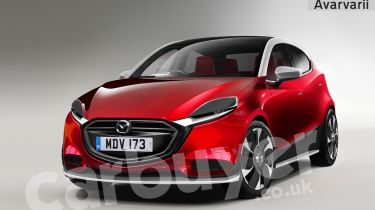Mazda to build electric Nissan Leaf rival
Mazda’s first battery-powered car expected in 2019; will rotary engine return to extend EV range?

Mazda will launch an all-electric rival to cars like the Nissan Leaf, Renault ZOE and BMW i3 in 2019 – and our exclusive renderings show how it could look.
The unnamed Mazda EV (electric vehicle) will spearhead a battery-powered offensive from the company, with Mazda likely to offer fully electric or hybrid options throughout most of its range and in most of the countries where it sells cars.
While other Japanese carmakers like Nissan and Toyota have cornered significant portions of the electric and hybrid markets, Mazda has yet to offer an alternative to its petrol and diesel engines to UK buyers – although a hybrid Mazda3 is sold in Japan. This is powered by technology from Toyota and it’s thought the relationship between the two companies will strengthen in the coming years, producing more Mazda EVs as a result.

Our exclusive renderings show how the new Mazda EV could look when it arrives in 2019. Company bosses told our sister publication Auto Express that its first electric vehicle would feature a “new design… [as] the technology is different”. Mazda’s European head of R&D, Matsuhiro Tanaka, went on to say that a small car makes most sense for the company, which would “develop a new material technology” to deal with the “heavy batteries” currently implicit in EV design.
There are also rumours future hybrid Mazdas could herald a rekindling of the company’s longstanding relationship with the rotary engine. Mazda has made cars with this unconventional engine for over half a century and although it’s known for its relatively high fuel consumption, it’s also famed for its smoothness and compact dimensions. Tanaka said the rotary engine is “very stable and quiet at standard revs”, hinting at the possibility it could feature in a range-extending capacity.
The range-extender version of the electric BMW i3 features a small motorcycle engine under its boot floor. Rather than powering the wheels directly, this charges the i3’s batteries when they’re low on juice. Using a quiet, smooth and compact rotary engine as a range extender is certainly an interesting proposition – and one Mazda is bound to have considered.
Most Popular

New Smart #5 Brabus is a 637bhp far cry from the brand’s city car past

Best car leasing deals 2025: this week’s top PCH offers
Tips & advice

Car dashboard warning lights: what does each symbol mean?

Electric car charging stations: public networks, charger types, apps and maps







